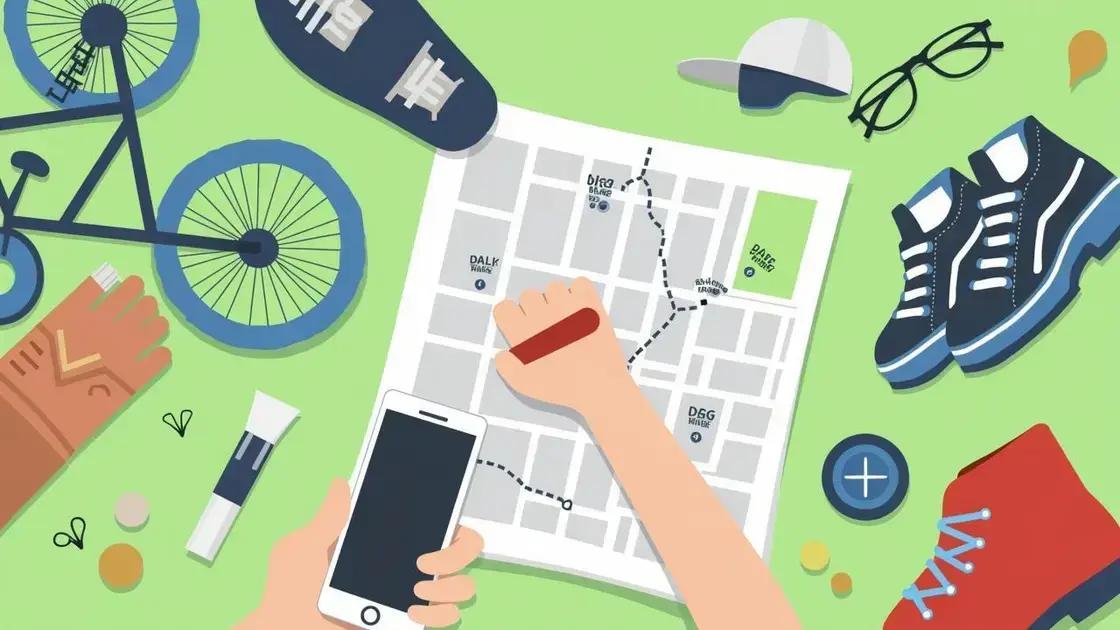Active commuting enhances health and well-being by incorporating walking or biking into daily routines. To start, choose your mode of transportation, plan your route, and gradually integrate it into your schedule while overcoming barriers like time, safety, and weather concerns.
In today’s fast-paced world, many people struggle with finding time for physical fitness. Active commuting offers a solution by transforming your daily travel into a workout. Whether you walk, bike, or jog to work, you can enhance your overall well-being while reducing your carbon footprint. This article will explore the benefits of active commuting, practical steps to start, and tips on how to integrate this healthy habit into your routine.
Benefits of Active Commuting

Active commuting provides multiple benefits that enhance your health and well-being. By walking, biking, or jogging to work, you can improve your physical fitness while enjoying your daily routine.
Improved Physical Health
One of the most significant advantages of active commuting is the boost to your physical health. Regular activity helps strengthen your heart, build stamina, and maintain a healthy weight. Studies suggest that engaging in just 30 minutes of activity daily can reduce the risk of chronic diseases.
Mental Well-Being
Active commuting also contributes to better mental health. Physical activities release endorphins, which enhance your mood and reduce stress. Starting your day with exercise helps you feel more focused and energized. It can turn your commute into a positive, freeing experience instead of a stressful one.
Time Efficiency
Using active commuting as a way to travel can help you multitask effectively. You can combine exercise with your daily errands, reducing the time spent on separate workouts. Additionally, avoiding traffic jams can save time, making your commute more enjoyable.
Environmental Impact
Active commuting is not just good for you; it’s also great for the environment. By choosing to bike or walk instead of driving, you reduce your carbon footprint. Less traffic means better air quality and a healthier planet for everyone.
Also, this shift to active commuting promotes a culture of sustainability, encouraging others to consider eco-friendly travel methods.
How to Start Active Commuting

Starting active commuting does not have to be complicated. It can be as simple as taking the first step towards a healthier lifestyle. Here are some practical steps to get you moving.
Choose the Right Mode of Transportation
Decide whether you want to walk, bike, or jog to work. Consider the distance, your fitness level, and your comfort. If you live close enough, walking might be the easiest option. On the other hand, biking can be faster for longer distances and can yield great fitness benefits.
Plan Your Route
Map out a safe and pleasant route for your commute. Use local maps or apps that show bike lanes and walking paths. If possible, choose a route with less traffic or scenic views to make your journey enjoyable. Familiarize yourself with your path, so you feel confident and safer.
Start Small
Begin with short commutes and gradually increase the distance as you build stamina. You can also start by walking or biking a few days a week and then add more days when you feel comfortable. This gradual approach helps you adjust and makes it easier to stick to your commitment.
Prepare for Success
Make sure you have proper gear for your active commute. If biking, ensure you have a suitable bike, helmet, and lights for visibility. For walking or jogging, wear comfortable shoes and clothes. You may also want to pack a change of clothes if you need to freshen up at work.
Additionally, set a routine by choosing specific days and times to commute actively. This will help establish the habit and integrate it into your daily routine.
Tips for Incorporating Active Commuting

Incorporating active commuting into your daily routine can be seamless with a few practical tips. Here are some suggestions to help you make active commuting a regular part of your life.
Create a Routine
Set specific days and times for active commuting. Establishing a routine makes it easier to stick to this healthier habit. Whether it’s every Monday, Wednesday, and Friday or just twice a week, consistency is key.
Buddy Up
Find a friend or coworker to join you on your commute. Having a commuting buddy can increase motivation and make the trip more enjoyable. You can encourage each other and stay committed to your goals.
Mix It Up
To keep things interesting, try mixing different modes of active commuting. For example, you could walk to work on some days, bike on others, or even take a longer route through a park. Changing your route can also expose you to new sights and keep the routine fresh.
Incorporate Active Breaks
If walking or biking every day feels overwhelming, consider incorporating shorter active breaks into your day. Take a brisk walk during your lunch break or choose to take the stairs instead of the elevator. Little changes can add up and make a significant difference.
Remember to celebrate your progress and achievements. Acknowledging your efforts will keep you motivated and make your active commuting journey enjoyable!
Overcoming Barriers to Active Commuting

While active commuting offers many benefits, you may face barriers that can make it challenging to adopt this practice. Here are some strategies to help you overcome common obstacles.
Lack of Time
One common barrier is not having enough time to commute actively. To address this, start by gradually integrating active commuting into your schedule. Consider walking or biking part of the way to work. You can also combine your commute with errands to make the most of your time.
Safety Concerns
Safety can be a major worry for those considering active commuting. Research safe routes ahead of time, focusing on bike lanes and walking paths. Wearing visible clothing and a helmet while biking can also enhance safety. If possible, choose routes with less traffic and well-lit areas to ease your concerns.
Weather Conditions
Weather can be unpredictable. On days with inclement weather, have alternative plans like public transport options that incorporate walking. Dressing appropriately for different weather conditions will also help you stay comfortable, whether it’s sunny or rainy.
Lack of Facilities
Some workplaces may not provide facilities for active commuters, making it harder to transition. Speak to your employer about adding bike racks or showers to enhance convenience. Many organizations are open to suggestions that promote employee well-being.
By implementing these strategies, you can effectively break down the barriers to active commuting and make it a viable part of your daily routine.
Making Active Commuting a Part of Your Life
Active commuting is a practical and beneficial strategy for enhancing both physical health and mental well-being. By incorporating activities like walking or biking into your daily routine, you can enjoy the advantages of better fitness while reducing your carbon footprint.
Remember that starting small and gradually increasing your commitment is key. Embrace tips to help you incorporate active commuting seamlessly and overcome any barriers you might encounter along the way.
With time, patience, and enthusiasm, active commuting can transform your daily routine into a healthier and more enjoyable experience. So, take that first step and explore the endless possibilities!
FAQ – Frequently Asked Questions about Active Commuting
What is active commuting?
Active commuting involves walking, biking, or jogging as a way to travel to work instead of using a car or public transportation.
What are the benefits of active commuting?
Active commuting improves physical health, boosts mental well-being, saves time, and helps reduce your carbon footprint.
How can I start active commuting?
Start by choosing the right mode of transportation, planning your route, and gradually increasing your commuting distance as you build stamina.
What tips can help me incorporate active commuting into my routine?
Create a routine, find a commuting buddy, mix up your transportation methods, and incorporate short active breaks into your day.
What barriers might I face when trying to commute actively?
Common barriers include lack of time, safety concerns, weather conditions, and insufficient facilities at your workplace.
How can I overcome the barriers to active commuting?
You can overcome barriers by planning safe routes, dressing appropriately for weather, starting with shorter commutes, and communicating with your employer about facility needs.












